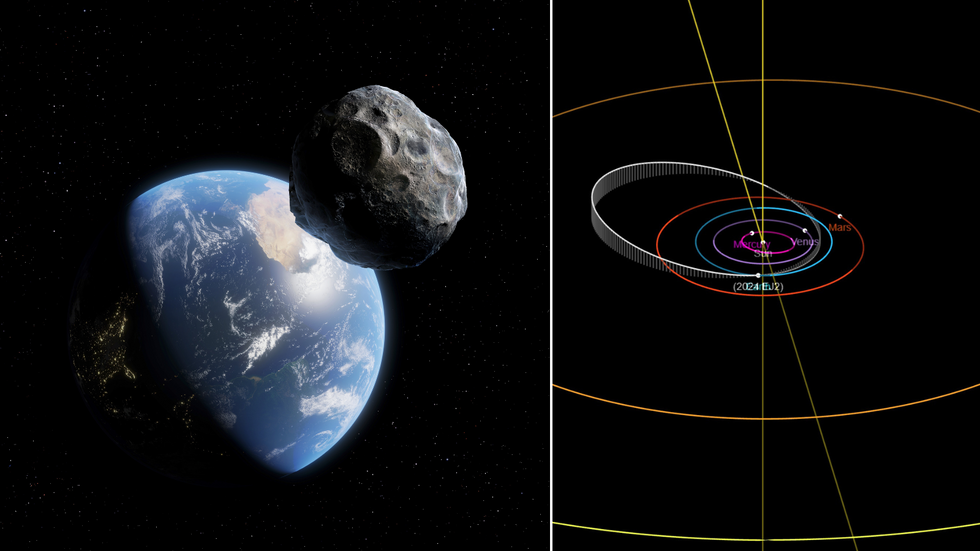2024 EJ2, as it’s known, will be closer to us than our own moon
Don't Miss
Most Read
Trending on GB News
An asteroid the size of a house, travelling at over 50,000 km per hour, is set for a near-miss with Earth today, Nasa has said.
The rock, named 2024 EJ2, will scream past our planet later today – and, at one point, will be closer to Earth than our own moon.
2024 EJ2 will fly by alongside four others today, according to Nasa’s Asteroid Watch database.
And images from Nasa’s Solar System Dynamics Lab have shown just how close it’s set to come.

The 2024 EJ2 asteroid, whose orbit is shown on the right in white, will pass us by as part of a set of five objects today
Getty/Nasa
Other members of the celestial quintet include two 7m-wide “bus-sized” asteroids, another the size of a house, and one, the largest, as wide as a commercial airliner is long, with a diameter of just shy of 60m.
At just under 20m across, 2024 EJ2 is the same size as the Chelyabinsk meteor – videos of which went viral when it blazed across the Russian sky in 2013.
The size and speed of our closest rocky passer-by means it would do some serious damage if it were drawn off course; an asteroid like this could quite feasibly flatten a small city on impact.
Fortunately, this asteroid is too small to be deemed a “potentially hazardous object” by Nasa – in order to receive this designation, an object must be larger than 150m across.
LATEST DEVELOPMENTS:

Images from Nasa's SSD Lab show how 2024 EJ2 will pass between Earth and the moon today
Nasa
This is the first time 2024 EJ2 will pass by our planet, but the asteroid is also set to give Earth a fly-by in 2031 – a little further away, however.
While today’s near-misser may be relatively small, as asteroids go, Nasa says that a huge space rock – up to a kilometre across – is set to shoot past Earth in April this year.
This huge object will pass Earth further away than the Moon, but much closer than our nearest planet, Venus.
Nasa has been tracking what they call “near-Earth objects” (NEOs) – asteroids and comets which orbit the Sun and come within 48 million km of Earth – for the last three decades.
But the space agency has taken special measures to counter the risk of “potential impact hazards”, establishing its Planetary Defense Coordination Office (PDCO) in 2016 “to find, track, characterise and mitigate against NEO impacts”.
The PDCO’s most impressive offering is its “Dart” – the Double Asteroid Redirection Test – where it can send a satellite past Earth’s orbit to “intentionally collide” with an asteroid, bumping it off course and protecting our planet.
But Nasa can’t see everything – earlier this year, an asteroid which ended up crashing down in northern Germany was only spotted by a Hungarian astronomer the day before.
The asteroid, named 2024 BX1, was only the eighth to be discovered before it hit the Earth.









